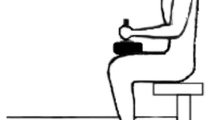Summary
The size of the maximalH-reflex (H max) was measured at rest and expressed as a percentage of the maximalM-response (M max) in 17 untrained subjects, 27 moderately trained subjects, 19 well-trained subjects and 7 dancers from the Royal Danish Ballet. TheH max/M max was significantly larger in the moderately and well-trained subjects than in the untrained subjects but smaller in the ballet dancers. It is therefore suggested that both the amount and the type of habitual activity may influence the excitability of spinal reflexes.
Similar content being viewed by others
References
Bhatia S, Irvine RE (1973) Electrical recording of ankle jerk in old age. Gerontol Clin 15:357–360
Buchthal F, Schmalbruch H (1976) Contraction times of reflexly activated motor units and excitability cycle of theH-reflex. Prog Brain Res 44:367–376
Burke RE (1981) Motor units: anatomy, physiology and functional organization. In: Brooks VB (ed) Handbook of physiology, section 1. The nervous system, vol. 2. American Physiological Society, Bethesda Md., pp 345–422
Casabona A, Polizzi MC, Perciavalle V (1990) Differences inH-reflex between athletes trained for explosive contractions and non-trained subjects. Eur J Appl Physiol 61:26–32
Devries HA, Wiswell RA, Romero GT, Heckathorne E (1985) Changes with age in monosynaptic reflexes elicited by mechanical and electrical stimulation. Am J Phys Med 64:71–81
Eccles JC (1953) The neurophysiological basis of mind. Oxford University Press, London
Eccles JC, Schmidt RF, Willis WD (1962) Presynaptic inhibition of the spinal cord monosynaptic reflex pathway. J Physiol 161:282–297
Goode DJ, Van Hoven J (1982) Loss of patellar and Achilles tendon reflexes in classical ballet dancers. Arch Neurol 39:323
Henneman E, Somjen G, Carpenter DO (1965) Functional significance of cell size in spinal motoneurons. J Neurophysiol 28:560–580
Henneman E, Clamann HP, Gillies JD (1974) Rank order of motoneurons within a pool: law of combination. J Neurophysiol 34:1338–1344
Hoffmann P (1910) Beitrag zur Kenntnis der menschlichen Reflexe mit besonderer Berücksichtigung der elektrischen Erscheinungen. Arch Anat Physiol 1:223–246
Hoffmann P (1918) Über die Beziehungen der Sehnenreflexe zur willkürlichen Bewegung, Z Biol 68:351–370
Hultborn H, Meunier S, Pierrot-Deseilligny E, Shindo M (1987) Changes in presynaptic inhibition of Ia fibres at the onset of voluntary contraction in man. J Physiol 389:757–772
Magladery JW, McDougal DB Jr (1950) Electrophysiological studies of nerve and reflex activity in normal man. I. Identification of certain reflexes in the electromyogram and the conduction velocity of peripheral nerve fibres. Johns Hopkins Hosp Bull 86:265–290
Milne JS, Williamson J (1972) The ankle jerk in older people. Gerontol Clin 14:86–88
Nielsen J, Kagamihara Y (1992) The regulation of disynaptic reciprocal la inhibition during co-contraction of antagonistic muscle in man. J Physiol 456:373–391
Nielsen J, Kagamihara Y (1993) The regulation of presynaptic inhibition during co-conctraction of antagonistic muscles in man. J Physiol, in press
Rochcongar P, Dassonville J, Le Bars R (1979) Modification of the Hoffmann reflex in function of athletic training. Eur J Appl Physiol 40:165–170
Sabbahi MA, Sedgwick EM (1982) Age-related changes in monosynaptic reflex excitability. J Gerantol 37:24–32
Schieppati M (1987) The Hoffmann reflex: a means of assessing spinal reflex excitability and its descending control in man. Prog Neurobiol 28:345–376
Schmidt RF (1971) Presynaptic inhibition in the vertebrate central nervous system. Ergeb Physiol 63:20–101
Small SA, Kandel ER, Hawkins RD (1989) Activity-dependent enhancement of presynaptic inhibition in Aplysia sensory neurons. Science 243:1603–1606
Taborikova H, Sax DS (1968) Motoneurone pool and theH-reflex. J Neurol Neurosurg Psychiatry 31:354–361
Wolpaw JR, Carp JS (1990) Memory traces in spinal cord. Trend Neurosci 13:137–142
Wolpaw JR, Lee CL (1989) Memory traces in primate spinal cord produced by operant conditioning ofH-reflex. J Neurophysiol 61:563–572
Author information
Authors and Affiliations
Rights and permissions
About this article
Cite this article
Nielsen, J., Crone, C. & Hultborn, H. H-reflexes are smaller in dancers from The Royal Danish Ballet than in well-trained athletes. Europ. J. Appl. Physiol. 66, 116–121 (1993). https://doi.org/10.1007/BF01427051
Accepted:
Issue Date:
DOI: https://doi.org/10.1007/BF01427051




